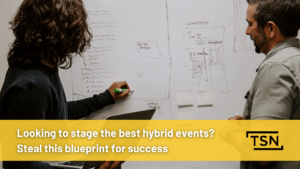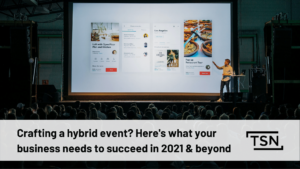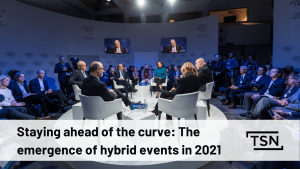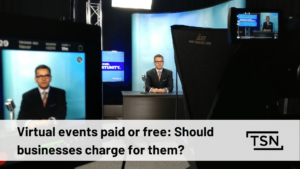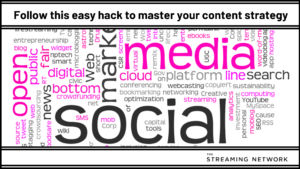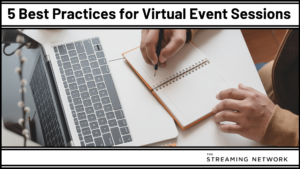Podcast: Play in new window | Download | Embed
Subscribe: Apple Podcasts | Google Podcasts | RSS
Webinars should be events that no one wants to miss.
In the second installment of Lessons from the Frontline, we discuss how marketers can engage audiences in real time to drive sales.
In Our Second Episode We Discuss:
- Buyer Personas: Recognize your ideal customer and the importance of leads that may possess purchasing authority.
- Bridging the Gap: Marketing may be sending over sales leads, but are they qualified leads? Webinars enable marketing teams to send the “Glengarry” leads more often.
- Modern Webinar Platforms: Automate the time-intensive parts of your marketing and sales funnel with advanced webinar platforms. It saves time and energy.
- Engagement: Make your participants feel like a part of the experience for better leads. This is crucial for successful webinars.
The Complete Video Transcript
Mr. Pete: Matt Ley, welcome back to Webinar Lessons from the Front Line. So, today we’re talking about return on investment.
Mr. Matt Ley: Correct.
Mr. Pete: There’s an investment that needs to be made, both in terms of time and money, to execute a webinar program. It’s something that’s essential, every business will want if they’re going to make that investment a definable ROI.
Mr. Matt Ley: Yep.
Mr. Pete: So, how do you, when you’re going out to a company, define ROI for your customers?
Mr. Matt Ley: That’s a good question, clearly. But I don’t, they do. So, when–.
Mr. Pete: –So–.
Mr. Matt Ley: –It’s their–every customer is different. So, recently I was out with a group of customers in Vancouver, two software companies out there. Spoke to two marketers and I asked the simple question, what does ROI look like for you? Like, what are you looking to achieve?
And oftentimes they’ll cite to me a number, a number of people through the program, because whether they’ve got a real data point that says that that will get to them to their goals this year or their boss said you need to drive this many leads through the webinar program, they quantify it by that number. And, depending on who they are, that number can be very, very different in that one company sells an average deal size of $75,000, plus, plus, plus with pro services and the other one has an average deal size of $500 and sales on that level don’t even engage. They want people buying online. It’s a B2B software play, but it’s a low sub.
So, in one case, they needed to get 3,000 people through in the course of 12 months, and in the other case, they needed to get 5,000 people in one week of events, a series of events. So, probably 5,000 a month is what they needed through. So, each of their KPIs were different, sort of, to get them to the ROI.
Now, unfortunately, that question is–that answer is always a number of people and it’s usually I need to get more, I need to get more, I need to get more. Because the idea is that more people through mean more revenue, more leads, or whatever it might be.
Mr. Pete: It’s the top–still the top of the funnel. You’ve got to get as many in the webinar–.
Mr. Matt Ley: –Yeah–.
Mr. Pete: –It’s like you got to get as many people through as possible.
Mr. Matt Ley: You do. You drive as many through as possible, but, you know, when I go out to–and this is what I try to instill in the end-marketers that I talk to–is that, you know, the last few conferences I’ve gone out to, marketing conferences, a lot of them were talking about the idea that followers and just the sheer volume of leads it’s an ego play. It’s not actually necessarily driving, driving revenue.
Because the third meeting I had in Vancouver was with a fairly large known social media software company that I think everyone can guess who it is. And they had a completely opposite problem in that their quarterly webinars drive like 10,000 registrants. They get so many people through their webinar program that sales doesn’t even want the leads or doesn’t want to follow up with them, because they don’t think that they’re good leads–.
Mr. Pete: –Right–.
Mr. Matt Ley: –They’re not qualified leads, right? And so, they’re looking to skim out of those 10,000 registrants, whatever it is, 7,000 viewers, 5000 viewers, they’re looking to skim out who are those that are engaged and at the right point in the buying cycle so that sales can engage. And I would argue, if you’re getting 10,000 registrants or you’re getting 10, the same math and the same logic should apply.
Mr. Pete: Right.
Mr. Matt Lay: Right? You’re going to get ROI if you can pick out from those viewers who are the most sales ready of the audience.
Mr. Pete: Right, which is absolutely logical. How do you respond, though? Because the person who has hired you may still want–because it does look good whatever–.
Mr. Matt Lay: –Yeah–.
Mr. Pete: –They gotta be able to go back. Is getting the numbers, a certain threshold of the numbers up, is that important? How do you do that? Like, what’s the process for that?
Mr. Matt Ley: Well, yeah, so generally what we do is in the last podcast that people listened to we talked about data sets and numbers and best practices. And so, we spend a lot of time documenting what are the best practices to driving registration? What are the things you need to do to convert viewership? And how do you reuse the content in the best way to get more people through the program?
So, definitely more is important. But I’ll tell a story that I tell quite often about a customer who–a big old global brand who, before they were working on our platform, were hosting these really huge webinars. They would bring out thought leaders and they would promote the hell out of them everywhere. And they would get thousands and thousands of viewers.
And then, once they moved to our platform, integrated with their marketing automation tool, and started to get a little more insight into what happens after someone views, they recognized the 7.2% of viewers became buyers inside of 90 days. And they could hang their hat on it. They could watch it happen.
So, for them, it was less about the thousands on these big webinars, because they needed to influence pipeline in a very complex organization that sells many products, has people at different stages of pipeline. And so, they took their data set that they had, that 7.2%, and they figured out how can they drive the most revenue and the right revenue. And they applied their webinar strategy to those problems.
So, we’ve got a lot of, call it, middle-of-funnel people on this product set. We will apply this month middle-of-the-funnel webinars to that product set to move those guys to purchases. If we’ve got low leads or a low funnel on this product set, we will apply webinars to that to start turning into more purchasers in that products set.
Mr. Pete: You can cater it based on the strategic–.
Mr. Matt Ley: –Yeah–.
Mr. Pete: –Goals and where people are within the purchase funnel?
Mr. Matt Ley: Exactly. But that’s only because they knew that that was their 7.2%.
Mr. Pete: Right.
Mr. Matt Lay: Now I say that to other people and they’re like 7.2%? We get like 20% turned into buyers. That’s great, that’s not these guys numbers.
Mr. Pete: Yeah.
Mr. Matt Lay: So, you gotta know your numbers kind of and how to get there.
Mr. Pete: Right.
Mr. Matt Ley: And although–I do agree, we all want more. We are having more and more conversations about the intelligence of the data and making sure that we are–even if we are getting more, that we’re pulling out the right leads. When you got the right leads and they get to sales, they respect the leads. And when sales and marketing have that bilateral respect going on between leads and going after them, that’s when real revenue impact starts occurring quicker.
Mr. Pete: Right, right. So, a lot of the conversation we’ve had–this is obviously an amazing tool for sales. People to get engaged, to go out there to tap into potential clients. But it’s–all content is, ultimately, a marketing vehicle–.
Mr. Matt Ley: –Yeah–.
Mr. Pete: –When you’re using content. So, you’re focusing on driving sales, but obviously you’re dealing with marketing departments as well, and in some cases they probably want to–they have their own objectives. They want to have more control over the process–.
Mr. Matt Ley: Well, 90% of the people who buy my product, or 90% of the people that work on the databases are marketers.
Mr. Pete: Right.
Mr. Matt Ley: The goal is to get people through their program to give them to sales.
Mr. Pete: Right.
Mr. Matt Ley: Right? And so, sales–they’re interesting folks. And I say this without, you know, having any problem with it, because I’m a salesperson.
Mr. Pete: Right.
Mr. Matt Ley: That’s where I came up through this. I learned this stuff through my engagements with customers, but I am, at the heart, a salesperson.
And, you know, sales will–my sales team even, so hopefully they don’t listen to this–but my sales team are like, where are the leads, Matt? Where are the leads? We need more leads. Then you give them leads, and what’s the first thing they say? The leads are crap. They’re not qualified.
Mr. Pete: Right.
Mr. Matt Ley: I’m not going to sift through all that crap, right? And so, as marketers, we have an amazing opportunity with the webinar to be able to hand to our sales team the Glengarry leads.
Mr. Pete: I knew you were going to Glengarry leads.
Mr. Matt Ley: Yeah. So, that–for those who are younger than us, I mean that list of leads of people that are both demographically right–they are a buyer, they are a buyer persona, whatever that looks like–and we know them to be in the buying cycle. They’re somebody who could tomorrow, with the proper pitch, timing, and understanding of their business, could buy our product. And that’s what we want to hand people.
I had a meeting with a marketer not too long ago. And we sat down and I started going through our pitch and we started talking about this to them, and they, like, stopped me and they basically said that, in their mind, their job is to bring someone all the way to contract negotiation. If they are doing their job right, sales is on the phone every day negotiating contracts. And to do that they need to have a lot of insights.
So, what we’ve sort of talked to people about is that, you know, you probably–as a marketer, you probably already got your demographic data down, right? So, I know that a marketing manager within a large organization who doesn’t have any buying authority is not going to be the person to sign my contract. They might be an influencer, but they’re not my buyer persona.
My buyer persona is quite a bit further up. They’re Director of Demand Gen, maybe in smaller organizations a VP Marketing. They usually don’t get their–into the webinar programs that much, but they might. But it’s that person who’s got the highest level of responsibility for leads in the organization who has the budget to buy my product.
Mr. Pete: Right.
Mr. Matt Ley: So, that’s my demographic. So, if you and me go to a webinar for somebody and your title is, you know, content or writer or journalist, whatever you write into that field when you sign up, and mine says president, the sales team, when they get all of the leads–if they just get all of them, 100 go–200, 300 go to them. They go in and they look at the information, I’m going to score really high demographically. I’m a president, I have purchasing authority. You’re going to score lower demographically, even if our organization is right for them, you’re going to be lower.
Now, if you stay on at that webinar and you spend the whole time with them. You’re there until the end. You might even go back–because you’re a journalistic type who likes to take notes, you might go back and watch the archive and maybe pull a few points or review a few things. You might ask a question. You might download a resource. You haven’t taken a step to say I want to talk to sales, but you’ve shown a great amount of engagement in the topic.
Now, let’s say I go to it and I stay for 20 minutes and then I leave. I may not have heard a single word of it. Someone could’ve come into my office. I grabbed my laptop, it was playing in the background. I paid no attention.
Mr. Pete: Yeah.
Mr. Matt Ley: Without that behavioural analytics or without that understanding of just how engaged you were, the sales team is going to look at it and I’m, in their mind, the Glengarry lead. But when they call me, I’m going to say I didn’t even look at the webinar.
Mr. Pete: Yeah.
Mr. Matt Ley: I–.
Mr. Pete: –Who–?
Mr. Matt Ley: –Yeah, I signed up for it. I didn’t see it. Is there a recording maybe I can get to you at some point? Send me that. I’m nowhere near it.
Mr. Pete: Yeah.
Mr. Matt Ley: They call you, there’s a chance you might have four or five, six, seven questions for them about the content because you were so engaged and you were so into it. And so, that behavioural–the right mix, in fact, is the buyer, me, at that behavioural level. That’s the Glengarry lead.
Mr. Pete: Yeah.
Mr. Matt Ley: But, in general, if you go to the accounts team, which you should, they will call and they will get an understanding of where you are. If you’re so low demographically, then maybe the SDR team tries to give you a call and see where you’re at.
Mr. Pete: Yeah.
Mr. Matt Ley: Or I shouldn’t–20 minutes, turning it off, I shouldn’t go to any salesperson. You’ve cultivated a new record in your database–that’s a president who’s in your buyer persona–but you haven’t done your job yet. It shouldn’t go to accounts until I’ve engaged a lot more, so I should go back into the trap.
Mr. Pete: Right. Is there a way to get that person reengaged with the content? Like you send it to them again? I guess there’s no way to know or–well, you know that they’ve watched it for 20 minutes.
Mr. Matt Ley: Yeah.
Mr. Pete: Do you need–can you move them into a better position through various techniques? Or is it kind of they didn’t buy into it, so we’re going to move on?
Mr. Matt Ley: Yeah, so I’m not going to pretend to know all the tactics that the modern marketer will use. But, generally speaking, I showed a level of interest. I’m not ready for the accounts team, maybe I’m not even ready for the SDR team, so I should be getting a more aggressive drip now after this.
Mr. Pete: Right.
Mr. Matt Ley: Right? So, if I was a suspect before who maybe went to your website once–in Canada, you gotta be castle [ph], so maybe I’m on the list.
Mr. Pete: Yeah.
Mr. Matt Ley: You’re going to have a certain amount of cadence in the way you communicate with me. Once I’ve taken that step of going to a webinar and participating for certain amount of time, definitely you’ve got the opening to hit me with more, right? So, give me more.
I didn’t watch the whole webinar, didn’t really participate. Maybe give me a tool or a white paper or an interactive tool that supports the content–.
Mr. Pete: –Right–.
Mr. Matt Ley: –And see if it was just a matter of time or whatever it might be. And then when I engage with that, you combine those few things–20 minutes on webinar, full engagement on an ion app or something–now I’m into that point where the accounts team is going to want to talk to me.
Mr. Pete: Right.
Mr. Matt Ley: See the problem is–I go back to that respect, right? I’ve seen it so many times.
I was on a call just the other day with a marketing consultant who was–who I had met at a conference and wanted to ask me some questions about this exact topic. And they’re like in B2B sales doesn’t respect MQLs. MQLs is BS for the B2B salesperson, which I can understand, you know what I mean?
We call it’s MQL and we give it to a salesperson. We hand it over like Alec Baldwin in the movie and we say this is a lead. And the person’s like, what are you talking about? I don’t know who you are. Then you lose your credibility.
But, I would argue that that’s just a problem with the way that we’re scoring an MQL. And I know why it’s hard, because when you’re using static content and when you don’t have any behavioral analytics on the person who downloads your e-book, that e-book might be a huge, high-value for–or high-value asset for you, but you have no way of knowing what I’ve done when I got it, right?
Like, maybe I didn’t even download it. I mean–actually you already know I downloaded it, but maybe I haven’t read it yet. I haven’t done anything with it. I didn’t like it. But when that e-book or that white paper is put into a webinar format conversation around it and I stay for 56 minutes and I ask questions and I do all the stuff that I referenced that you did, now you know I’m engaged with that content.
And so, I can’t blame sales for saying they don’t respect MQLs. I know there’s a lot of talk about getting the whole word MQL just thrown out of the lexicon.
Mr. Pete: Right.
Mr. Matt Ley: Right? Sales ready, get them to take action right then and there. But, I think it’s our responsibility to ensure that we are handing over only the best to the accounts team. And that’s why, in our space, we share–you got to be pretty high demographically and behaviorally when you come through a webinar before you go to our senior account reps.
Mr. Pete: Right.
Mr. Matt Ley: We’ll give more to the BDRs than some will and we’ll keep some in drip, but you’ve got to be–we got to be pretty sure that you’re ready to go if we’re going to give you to an account rep.
Mr. Pete: Right, okay. What role does the platform–having a really kick-ass platform play in developing ROI? Because a lot of people do go without–.
Mr. Matt Ley: –Yeah–.
Mr. Pete: –So what’s the thing? Sell to us.
Mr. Matt Ley: Sure. Well, I think there’s going to be a whole webinar on–or a whole podcast on the topic of a platform, but I’ll give you a few things is that there’s always a way of doing something that’s manual, right? We all have done that in each of our businesses. We have, you know, decided that we were going to take a spreadsheet and we’re going to manipulate it 17 different ways or maintain a Google Doc by dumping data out of one system and uploading it to another system.
But, when it relies so heavily on human beings to do those tasks like an assembly line–and we know that our offices don’t work like Ford–we drop the ball. We fall down. And so, sometimes the webinar–people have less respect for the webinar because it’s just too damn hard to get all the great things I’m talking about out of it.
Mr. Pete: Right.
Mr. Matt Ley: So, the modern webinar platforms, the newer ones like the ones–the elite platform that we are out selling on the street–and there’s others that are similar who have taken an approach that it makes sense for marketers. They automate a lot of the hard stuff.
So, they automate some follow-up emails. They automate archiving. They automate data collection. They automate a lot of stuff or they even automate the flow of data into certain other technologies, like CRM and marketing automation. So, you’re not sending sales MQLs or SQLs, they’re automatically going to the right salesperson.
And when that automation is in play, then it just gets a lot easier to get our ROI out of it. So, that’s number one.
And I would say that the other thing that everyone should be looking at is what we call an active archive, or–an active archive is that your webinar doesn’t get turned into a video that gets posted online. The stats on watching video online, like on YouTube and stuff, I mean, they’re shrinking. Facebook apparently lied about all their video stats just recently. And part of that is because, let’s face it, a lot of the stuff is just–when it’s converted into a video, is just slides and some guy talking.
So, what an active archive is–and a lot of platforms do this–is they allow people to interact with the content. You–when you went to the mall on Christmas Eve back in the day, if you were like me, to buy for your family, you wandered in and out of stores. You spent three or four hours trying to get your shopping done. Now, on Christmas Eve, when I’m on my phone on the way to the office doing the last–well, maybe not Christmas Eve, but you know what I mean? On my phone on Amazon.
Mr. Pete: –Give you a couple weeks, yeah–.
Mr. Matt Ley: –I’m going straight to the thing I want–.
Mr. Pete: –Yeah–.
Mr. Matt Ley: –And I’m buying it, right? I might cross-check pricing and stuff like that, but it’s happening. I need what I want, when I want it.
Mr. Pete: Yeah.
Mr. Matt Ley: Your viewer’s the same way. They go on demand, they watch a video of yours on-demand and they hear something that interests them, they need to be able to take action right then and there. They need to be able to click and do things. And an active archive allows them to continue to respond to polls, download resources, send questions, and all of that fun stuff.
Mr. Pete: Right.
Mr. Matt Ley: So, I would say that those are the two major things, but again, we could do a whole 30 minutes on the topic of what makes a platform–.
Mr. Pete: –Yeah–.
Mr. Matt Ley: –Help with all of this.
Mr. Pete: And we will.
Mr. Matt Ley: And we will.
Mr. Pete: Marketers rely on these platforms for sales. It’s meant to drive–as a marketing initiative to drive sales.
Mr. Matt Ley: Yeah.
Mr. Pete: So, what do you say to marketers when the sales don’t come?
Mr. Matt Ley: That the sales team sucks.
Mr. Pete: Yeah.
Mr. Matt Ley: I mean that’s why–.
Mr. Pete: –Fire your sales team–.
Mr. Matt Ley: –I think that’s why there’s a new role like CRO that kind of bridges the gap.
But, yeah, I mean, we talked earlier about the disconnect if you’re sending the wrong leads their way, but what happens if they’re not converting on the leads? And there’s a bunch of stuff happening now that I’m reading about with BDRs moving under the marketer, not the sales leader. Sales leader is just the accounts team.
There’s a lot of–I think a lot of change is happening as marketing gains more control. But I would argue that marketing can take control and in taking control, they should learn from sales.
Mr. Pete: Right.
Mr. Matt Ley: So, you know, we go through–you know, we went through models here about the idea that those who are most engaged in a webinar are at the highest level of sales readiness. They are the ones that go to sales.
Well, we’ve had marketers who have taken it completely out of sales’ hands entirely. Why have a sales rep or BDR follow up with you when you come to my webinar and you’ve done all this stuff? Why not just ask you?
So, QASymphony, who’s a customer case study for the platform, gets about 1,000 viewers, so they’re up in that top 9% of viewers, and they found that they had a pretty engaged group of audience members who were pretty likely to take a meeting. And what they did was they sent emails afterwards or they had sales follow-up afterwards.
And one marketer said, you know what, forget this. I’m just going to ask the audience at the end of the webinar. If they stay to the end and they visit this whole thing, they are highly likely to take a meeting. Why wait for any other human to follow up with them to book said meeting? We’re just going to ask them, very casually–.
Mr. Pete: –On the spot–.
Mr. Matt Ley: –On the spot. Those of you who are ready to take the next step, click here. And they click a button on a poll and then those are booked–a commitment from that prospect or suspect to go to the next stage, which is take a meeting.
So, I would suggest that marketers learn from the best sales people in the organization: If you don’t ask for the business, you’re never going to get it.
Mr. Pete: Right.
Mr. Matt Ley: Right? And there’s no time like now.
In between a webinar, where hopefully you’ve told some great stories, made an emotional connection, backed that up with some great data sets or some great customer stories, and people are feeling like, you know what, you might be right for us, what occurs between that and then even the next day email follow-up?
Because when I bring this up to some marketers they’re like, yeah, we always ask them in the email follow-up if they would like to get a demo or talk to sales. Well, who knows what happened in that 24 hours?
Maybe they got their numbers and they lost their budget. Maybe they–who knows? Some good–something good might’ve happened. Maybe they talked to a friend. Who knows? You have them there in that moment–.
Mr. Pete: –Yeah–.
Mr. Matt Ley: –You ask them then and there.
Mr. Pete: And if–the adrenaline is going.
Mr. Matt Ley: Exactly.
Mr. Pete: They’re feeling good about it. By the next day, they are getting up–.
Mr. Matt Ley: –Who knows what’s going on since then, right?
Mr. Pete: You’ve lost the momentum.
Mr. Matt Ley: Right.
So, we talked to sales and what is, you know, what is the high-value thing that you want to ask? Is it getting them to a demo? Is it getting them a trial? Is it filling out a form to get a quote? Is a quote the start of a sales process?
Mr. Pete: Right.
Mr. Matt Ley: Every sales is different. And if you’re going to be getting your sales reps those Glengarry leads and all they’re going to be doing is negotiating contracts, then you need to be a little more bullish in what you’re doing. Even in a thought leadership style.
I’ll give you one more real example and it’s the HubSpot example, which I’ve stolen ideas for from my webinars and I’ve told probably 1,000 times since I met the marketers down in San Francisco. But, basically, they recognize that they’ve got this one form that’s super high-value. It’s a website analysis form, which basically measures how good they are–how good their website is built for inbound.
Really, it’s a form that the sales rep needs to do their first meeting. That’s all it is. It gives the sales rep enough information that they can go in and have an educated conversation of how HubSpot might be able to help them based around this form.
Mr. Pete: Right.
Mr. Matt Ley: So, when they realized that that was their most high-value form, that’s the form that was getting them–meetings with that form filled out were closing more than meetings without that form filled out, they built a webinar program around. And what they did is they said, hey, who wants to be part of our next webinar? Fill out this form and we’re going to analyze your website for free for you with super, you know, analysts, Matt and Pete Vanalis.
And every webinar has three websites analyzed. These two experts will sit there and talk about it, pick it apart a bit, make jokes about it–.
Mr. Pete: –Right–.
Mr. Matt Ley: –Say the good things. And they–because they’re HubSpot and they’re super cool, when it ends someone throws a ping-pong ball at the presenters and they move on to the next website.
Mr. Pete: Right.
Mr. Matt Ley: And so, highly attended, tons of fun. Low rent. Not in a nice studio like you’ve got here, but in a–just at a desk with a couple of hot cameras like on the–like those high sort of web cams. It’s not like it’s overly produced, but it’s super fun. I’ve watched a couple and I’ve learned a lot from them.
But throughout they keep asking. Before the event, when someone registers they say, okay, so you’ve come to watch these guys get their websites torn apart; do you want yours torn apart? Fill out this form. During the webinar: If you’re brave enough, you can be on our next one. And if not, click here to get a one on one.
Mr. Pete: Right.
Mr. Matt Ley: And post webinar they’re asking again. They continuously are just asking people to fill out this high-value form and, as such, they’re getting a 36% hit rate on the form being filled out by people who attend the webinar.
Mr. Pete: Right.
Mr. Matt Ley: So, that’s 36% of probably thousands–I don’t know the numbers on their program–who are putting their sales in the best position to close–.
Mr. Pete: –Right–.
Mr. Matt Ley: –With all the information that they need. And, that is, you know, basically a marketer asking a–taking a sales step: fill this out and we’ll talk to you. Take that next step.
Mr. Pete: Yeah, yeah.
Mr. Matt Ley: And so, I think that marketers can take more control. I think that of all of the digital mediums that are available to them, that the webinar gives them a unique opportunity to take control. Because while they are giving them something, i.e., this great thought leadership piece, this great thing, they can then say–ask for something back.
Mr. Pete: Yeah.
Mr. Matt Ley: That’s not generally how it works in any sort of other content asset.
Mr. Pete: That’s–yeah, that’s that two-way thing, right?
Mr. Matt Ley: Yeah.
Mr. Pete: 100%.
So, it’s time for our challenge. I’ve heard you say many times that webinar viewers do not like to take action.
Mr. Matt Ley: Right.
Mr. Pete: It’s an issue– they can–.
Mr. Matt Ley: –Yeah–.
Mr. Pete: –Obviously, there’s ways to make them, induce them to take action, but most prefer to sit back. So, you just talked about one example where–.
Mr. Matt Ley: –Yeah–.
Mr. Pete: –Somebody takes action, but what are some other techniques? How do you get people to actually take action with a webinar?
Mr. Matt Ley: You know, Pete, this is only the second interview that you’ve done with me, but I have to say the questions today are a lot more intelligent.
Mr. Pete: Oh.
Mr. Matt Ley: What did you–?
Mr. Pete: –Thank you–.
Mr. Matt Ley: –What happened between this podcast and the last podcast?
Mr. Pete: I don’t know. I must be learning as we go.
Mr. Matt Ley: Yeah. So, what I was trying to do there was a bit of a psychological–.
Mr. Pete: –Yeah, no, I got it–.
Mr. Matt Ley: –Technique on you, right? You know, you’re playing–my favourite sport that I play now, probably because I’m older and not in as good a shape, is ping-pong, that’s a big thing. But, when you’re playing sports with somebody, they say a good tactic if that person is hitting their forehand really good, hitting that three-point jump shot, is you ask them what are you doing differently? What are you doing? And have them analyze what it is they’re doing.
Mr. Pete: Right.
Mr. Matt Ley: It will generally get them off their game.
Mr. Pete: Right.
Mr. Matt Ley: Right?
Mr. Pete: You can mess them up.
Mr. Matt Ley: You can mess them up–.
Mr. Pete: –Yeah–.
Mr. Matt Ley: –Through psychology.
Mr. Pete: Thinking about how you’re walking.
Mr. Matt Ley: Exactly.
Mr. Pete: Look how you’re walking–.
Mr. Matt Ley: –Yeah–.
Mr. Pete: –All of a sudden you stumble, right?
Mr. Matt Ley: What’s your gait like? And then all of a sudden they’re like, whoa, I walk weird all of a sudden.
Mr. Pete: Yeah.
Mr. Matt Lay: And so, that’s the negative side of it. But psychology can be employed throughout your webinar presentation to induce more engagement from your audience and get them clicking.
Mr. Pete: Yeah.
Mr. Matt Ley: So, while we’re here one-on-one and I maybe or maybe didn’t make you feel uncomfortable with that question–.
Mr. Pete: –No, it felt great. Are you kidding?
Mr. Matt Ley: En masse, one of the things is that, generally when you’re going to ask for them to take this big action–like I said do you want to take the next step–it occurs towards the end of the webinar when you’ve already accepted some questions.
So, one simple one would be to, you know, talk about just how smart the audience is. I cannot believe how great these questions are, what a smart audience we have. So, you’ve complimented them on their intelligence before you’re asking them to do something–.
Mr. Pete: –Right–.
Mr. Matt Ley: –Like take said action. And smart people would take this action, right? And so, they could take–they would take that action.
The next podcast, or one of the future podcasts that you told me we want to do, is we want to talk about getting people engaged. And we want to talk about people taking action.
Mr. Pete: Right.
Mr. Matt Ley: And–.
Mr. Pete: –Probably the most important, single thing.
Mr. Matt Ley: Well, yeah. Without it, you know, all the tools, all the interactions, all the–everything we talked about about best practices and all of that–.
Mr. Pete: –Yeah–.
Mr. Matt Ley: –It all kind of falls apart when an audience sits back and does nothing–.
Mr. Pete: –Yeah–.
Mr. Matt Ley: –Like you mentioned they’re prone to do.
Mr. Pete: Yeah.
Mr. Matt Ley: Like, the data indicates less than 10% of people are going to ask a question, less than 10% of people are going to respond to a survey. That number goes further down when you send out the survey after the webinar. They could care less about filling out your survey, right?
Mr. Pete: Yeah, yeah.
Mr. Matt Ley: You’re not getting people to take action if they’re not doing it throughout the entirety of the experience, right?
Mr. Pete: Right.
Mr. Matt Ley: So, psychology does come into play. And the biggest thing I can say in case people don’t view the next podcast, which–or listen to it, which we’ll get into it, is that you need to make them feel part of the experience.
The best TED Talk, even if they’re just up there talking, makes you feel like you’re a part of it, even when you’re watching it on YouTube. It’s got you thinking in your head about big, powerful questions, and then when they give you answers later on that you’re like, oh my God, the aha moment. They’re making you feel like you’re somehow–they’re talking to you and you’re part of that experience.
No matter how good of a presenter you are, how dynamic, or energized, or excited you are about your content is–they might remember that, but they’re not going to feel like they’re part of it if you don’t do that.
Mr. Pete: Right.
Mr. Matt Ley: TED talks are generally the best presenters. That’s how they get–well, I shouldn’t say that. I think TEDx we’ve got a lot of, you know, not great ones out there anymore, but, generally speaking, you’re a great presenter. You’ve got a great presentation. You’re being asked to go out there, you know how to employ this. Our speakers in each of our businesses do not.
Mr. Pete: Right.
Mr. Matt Ley: And so, you want to create a format that makes them feel involved.
Mr. Pete: Right.
Mr. Matt Ley: Right? So, I think I’m going to stop with that. There are ways of getting them to take action and we’ll talk about it.
Mr. Pete: We’ll talk about it in the next one.
Mr. Matt Ley: That’s right.
Mr. Pete: Matt, thank you very much, again, for the great information.
For those listening, share this with people. This is some great business insight. There’s all kinds of businesses that should be interested in webinars and you probably know a few people. A great way to get the word out about your business and engage your clients.
So, share this with whoever you think and we’ll have another episode coming soon.
Mr. Matt Ley: Sounds good. Thanks, Pete.
Mr. Pete: Thank you.

